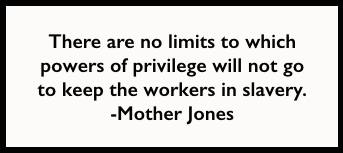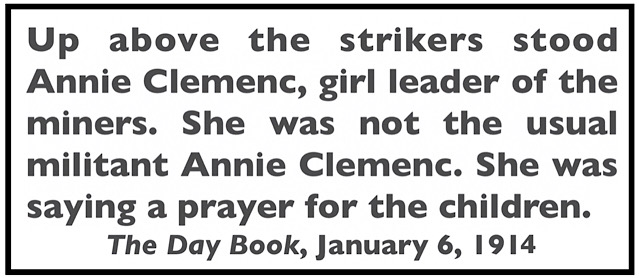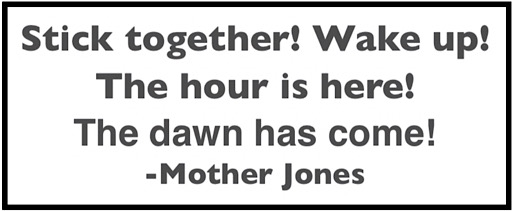 —————
—————
Hellraisers Journal – Friday January 16, 1914
Houghton, Michigan – Cheering Crowd Meets Moyer and Tanner at Station
From the Miners Magazine of January 15, 1914:
From the Miners’ Bulletin of January 9, 1914:
 —————
—————
Hellraisers Journal – Friday January 16, 1914
Houghton, Michigan – Cheering Crowd Meets Moyer and Tanner at Station
From the Miners Magazine of January 15, 1914:
From the Miners’ Bulletin of January 9, 1914:
 —————
—————
Hellraisers Journal – Friday January 9, 1914
Chicago, Illinois – President Moyer after Operation with Walker, Terzich and Riley
From Miners Magazine of January 8, 1914:
 —————
—————
Hellraisers Journal – Tuesday January 6, 1914
Calumet, Michigan – Mothers, Fathers, Sisters, Brothers Follow Small White Caskets
From the Chicago Day Book of January 6, 1914:
MOVIES SHOW GHASTLINESS OF CALUMET’S
RECENT FIRE CATASTROPHE[by Editor N. D Cochran]
[Note: There was no fire; the stampede to the stairway was caused by a man, wearing a Citizens Alliance button, who intentionally raised a false alarm of fire.]
There were two exhibitions of the moving pictures of the funeral of the victims of the Christmas eve disaster in Calumet yesterday.
In the little hall up three flights of stairs on North Clark street the picture received its baptism.
Its sponsors were two members of the Western Federation of Miners, three motion picture operators-one of whom had taken the picture-a picture producer, two newspapermen and an express wagon driver who had wandered into the darkened, bare hall, and stayed to watch the film unreeled, held by the power of the spectacle presented.
In the comments of the spectators was revealed the appeal of the picture.
Scenes of disaster, of misery and suffering were no strangers to those present. But the pathos of the picture pierced the veneer of cynicism and struck home.
With a flare and sputter the picture flashed on the little screen, revealing the church at which the service for the 57 victims buried was held.
Hundreds milled around the doors struggling to gain an entrance. Children predominated in the crowd, seeking to pay a final tribute to their playmates, whose lives had been so needlessly crushed out because someone had made a fatal blunder or worse.
A fine snow was falling, and the streets were covered with white. But the picture was wonderfully clear.
“Good stuff,” commented one of the picture men. “Notice how those buildings in the background stand out?”
An interurban car wormed, its way through the crowd which choked the street.
“H–l! Don’t them street car people there care nothing for a funeral,” came from the expressman, not conscious that he was speaking aloud.
A quick change in the picture, and the first coffin was brought from the church door. It was white and small. Nearly all of the coffins were white and small.
On the shoulders of four men the little box was borne down the steps of the church and placed in a waiting hearse. Another followed. And then another. They came in such quick succession that they could not be counted.
The supply of hearses ran out. And then came the most moving part of the picture. Two squads of four men each were assigned to a coffin and the coffin was carried aloft on their shoulders. When one squad tired another leaped to take its place.
A second street car sundered the head of the cortege as it started on its long march to the burying ground.
A quick transformation, and the scene changed to the funeral procession nearing the cemetery. Down the narrow ribbon of road it came, across the plain from Calumet. The road was a mass of black against the snowy wastes of the surrounding country.
Hearse after hearse passed. Some of the bodies were conveyed in sleighs. And then came the men marching with the coffins on their shoulders. They were carried two abreast.
Across the sky line was a smudge of smoke from one of the Calumet & Hecla mines. While the strikers were burying their dead the work of the mines went on. In the foreground loomed the shaft of the Red Jacket mine, where, many of the men had toiled before they went on strike.
“That sky line stuff is great,” commented one of the picture, operators “You can see people clear back to the town, and it must be a couple of miles away.”
“Yet they say there are only 3,000 of us on strike,” muttered Yanco Terzich, member of the miners’ union, who has guarded the film since it was brought from Calumet. “Look at those people. There are 15,000 in line. There would have been more, but they didn’t have the railroad fare. They have to eat.”
Following the last coffin came the women, the mothers of the children whose bodies were being borne on ahead. In a solid mass they marched, thousands of them. Many were weeping. Children clung to their hands, sobbing for sisters or brothers who were lying in the little white caskets carried on the shoulders of the men.
And then came the strikers. They were grim, tight-lipped, looking straight ahead toward the burying ground. At their head was a woman carrying an American flag shrouded in black.
Anarchists these men have been called. But they marched behind the flag that the militiamen had tried to take from them. They did not look like anarchists. They seemed to be very ordinary men, bundled in their fur caps and great coats.
On they came. When the head of the procession reached the cemetery the rear was still resting in the city.
A close view of the two trenches in which the bodies were laid was thrown on the screen. Up above the strikers stood Annie Clemenc, girl leader of the miners. She was not the usual militant Annie Clemenc. She was saying a prayer for the children.
The picture machine sputtered and the screen went dark. The reel of film had been run.
“That’s great stuff,” said one of the reporters. “But how are you going to write about it? How can you make people feel that picture by hammering a typewriter. They’ve got to see it. It’s too big for me.”
And it is too big. You do have to see it. It is like nothing ever pictured before.
Later the film was taken to the city hall to be passed on by the board of censors, of which Police Sergt. Jerry O’Connor is chief.
It was run so they might approve, which they did.
“There’s nothing harmful in that picture,” was O’Connor’s verdict. “But I think it is too long.”
It is too long-too pitifully long-though not in the way O’Connor meant.
[Photograph and emphasis added.]
 —————
—————
Hellraisers Journal – Monday December 29, 1913
Chicago, Illinois – W. F. of M. President Charles Moyer Expected to Recover
From The Day Book of December 29, 1913:
———-
———-
———-
 —————
—————
Hellraisers Journal – Sunday December 14, 1913
Michigan Copper Country – MacNaughton’s Eye, Threats and Mob Rule
From the Michigan Miners Bulletin of December 2, 1913:
“Seen by the Search-Light” is a regular feature of the Miners’ Bulletin and refers to “MacNaughton’s Eye,” the giant searchlight that James MacNaughton, manager of the Calumet and Hecla Mining Company, has had erected on top of the main tower situated in the middle of the town of Calumet, Michigan. The searchlight roams about the streets of Calumet, keeping a watchful eye on strikers and scabs alike. It shines into windows of the homes of the residents, interfering with a peaceful night’s rest. Of course most of those streets, the houses, and the property upon which the town itself sits, is owned by C & H. Therefore, we suppose, MacNaughton has a perfect right to make of the town something resembling a prison.
Seen by the Search-Light
Senator James, in his office staring at the labor situation of the day, and concluding to remain silent; to draw the votes from both sides at election time.
James Torreana, the Laurium scab supporter, at mid-night when the Hyena walks around the graveyard walls, going to meet the modern Judas A. C. Marinelli, to furnish him with news of strike-breaking nature.
Mike Bargo, the Italian scab herder at the telephone, communicating some scabious news to the “Gazette.”
A small man with spectacles riding a bicycle, from West Portland St. to the office of “The Italian Miner” of Laurium, with a parcel of written matter for publication.
Paul Tinetti looking at Pietro Micca’s picture.
5th St.-The green grass growing in front of Keckonen store, but no other place for lack of pollen matter in the seeds.
[Emphasis added.]
Regarding the “green grass growing,” we will remind our readers that MacNaughton has vowed that “grass would grow in the streets” of Calumet before he would treat with the Western Federation of Miners. This kind man has also vowed to teach the strikers and their families how to eat potato pairings.
Poetry from Miners Bulletin of December 2, 1913:
THE WORKER
By Berton BraleyI have broken my hands on your granite,
I have broken my strength on your steel,
I have sweated through years for your pleasure,
I have worked like a slave for your weal.
And what is the wage you have paid me.
You masters and drivers of men?
-Enough so I come in my hunger
To beg for more labor again!I have given my manhood to serve you,
I have given my gladness of youth;
You have used me, and spent me, and crushed me,
And thrown me aside without ruth;
You have shut my eyes off from the sunlight,
My lungs from the untainted air;
You have housed me in horrible places.
Surrounded by squalor and care.I have built you the world in its beauty,
I have brought you the glory of spoil;
You have blighted my sons and my daughters,
You have scourged me again to my toil.
Yet I suffer it all in my patience,
For somehow I dimly have known
That some day the worker will conquer
In a world that was meant for his own!
—————
 —————
—————
Hellraisers Journal – Wednesday August 27, 1913
Michigan Copper Country – John Walker and John Mitchell Speak to Strikers
From The Calumet News of August 23, 1913:
Note: John Walker reported that the military presence in Michigan’s Copper Country is brutal, and that General Abbey’s troops are acting as:
scab herders, strike-breakers, and black-leg protectors..[who] have shot people in the back, browbeaten men and women, insulted women and girls, and after filling up on beer and whisky sent them by the mine owners, swaggered up and down the streets with their big guns and sabers, a disgrace to the rottenest government on earth, let alone ours……
 —————
—————
Hellraisers Journal – Thursday July 24, 1913
Copper Country, Michigan – General Strike Begins, Led by W. F. of M.
From The Calumet News (Michigan) of July 23, 1913:
The first general strike in the history of the Lake Superior copper region. which has long been forecasted, become a realization today. Following a mass meeting of the miners, called by local officers of the Western Federation of Miners last evening, the strike was declared this morning, and underground operations have been suspended at practically every mine in the Lake Superior copper region.
Local officials of the Western Federation of Miners give the folowing as the principal demands of the strikers:
Recognition of the union.
Shorter hours.
Increased wages.
Two men to operate the one-man drilling machine.Three members of executive board of the Western Federation of Miners, Guy Miller, J. C. Lowney and Janco Tersich are here to direct the strike. They state the strike will be financed by the Western Federation of Miners and the American Federation of Labor, and that the men are prepared to hold out as long as necessary to gain the points for which they are contending.
Union officials claim the membership in the Western Federation of Miners is 9,000, out of a total of 11,000 men employed in underground work in the district.
Strike Is General.
The surface as well as the underground employes of some of the mines, laid down their tools this morning, declining to go to work, but this is the exception to the rule, for at most of the mines the surface work has not been interrupted so far. The strike, however, is general throughout the entire district, about the only mines now affected so far being the Hancock, Winona and Franklin. At the latter mine a few of the men remained away from work today, but operations continue as usual.
At the Mohawk. Ahmeek, Allouez and Centennial mines, underground was suspended, and at the Wolverine mine, surface as well as underground work came to a stop. No mining work was conducted at the Tamarack, Osceola or Kearsarge shafts today, and the same condition prevailed at Quincy, Isle Royale, Superior and other mines in the portage Lake territory. Work was started at two shafts, the No. 4 and 6 shafts the Isle Royale this morning as usual, but later was discontinued. The shut down at the Champion, Trimountain and Baltic Mines of the Copper Range Consolidated and the Houghton Copper company is complete, as well as all other mines except Winona, Hancock, and Franklin.
It is understood the mining companies will decline to recognize the Western Federation of Miners.
No Disturbances Reported.
The strike is being conducted in an orderly manner so far. Except for the air of suppressed excitement which prevails, it would be difficult to realize a strike is in progress in the district. At some of the shafts and mine buildings the men congregated and discussed the situation, but for the most part the men returned to their homes when they discovered the strike was on.
General Manager James MacNaughton of the C. & H. Mining company was asked for a statement today, but declined to be quoted at this time.
[Emphasis added.]

~~~~~~~~~~~~~~~~~~~~~~~~~~~~~~~~~~~~~~~~~~~~~
Hellraisers Journal – Wednesday November 20, 1918
Laredo, Texas – Charles Moyer Spews Bitter Venom at Bill Haywood
With great sadness we report and correct the half-truths and untruths spewed by Charles Moyer at Big Bill Haywood during the recent Pan American Labor Conference held at Laredo, Texas. Charles Moyer knows what it is to face the persecutions of the ruling class. He nearly lost his life in the 1913 Michigan Copper Miners strike when he was kidnapped, shot, and deported from the strike zone by company gunthugs.
From the Chicago Day Book of December 29, 1913:
He nevertheless returned to the strike zone after his release from the hospital, and was greeted by thousands of cheering strikers and their families. That this hero would now turn on his fellow workers brings deep disappointment and sadness.